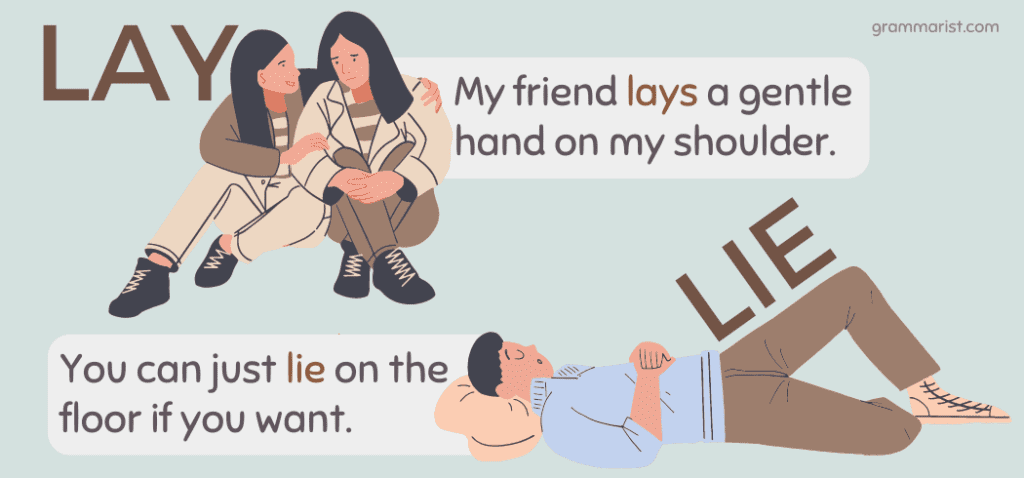There are many words in the English language that sound or look alike and can cause confusion for those new to the written language.
Lay and lie are two examples since when they are conjugated, they look and sound similar to one another. This is especially confusing to anyone new to the language. And I’ve watched many English Language Learners struggle with choosing which conjugation to use in both speech and writing.
That’s why we have provided a quick chart below, as well as an explanation of use with examples to help you get lay vs. lie right each and every time.

What Does Lay Mean?
Lay is a transitive verb and requires a direct object when used properly in a sentence. By definition, it means to place (or put) something or someone down in a resting position.
For example:
- Be sure to lay a blanket on the floor before you place the baby down.
- My mother lays a gentle hand on my shoulder.
- Just lay those bags on the counter, and I’ll put them away later.
What Does Lie Mean?
The word lie is most commonly used to explain that an untruth has been told. But, when used as a verb, it means to rest or recline in a flat position on a surface. Lie is an intransitive verb and does not take a direct object within a sentence.
For example:
- Just lie on the couch until your headache goes away.
- How can you just lie there with so much going on?
Difference Between Lay and Lie
Figuring out the difference between how to use lay vs. lie is where things get confusing. This is where it gets weird, especially in the past-tense and past-participial inflections of lie, which sounds like they should correspond to lay.
This is because lay is also the irregular past tense form of lie.
But the correct usage is simple: Lay needs an object—something being laid—while lie cannot have an object. For example, you might lay a book on the table, lay a sweater on the bed, or lay a child in her crib. When you feel tired at the end of the day, you may lie down. But you can’t lie a book anywhere, and you can’t lay down (no object) at the end of the day.
Use this verb tense chart to help you see where people get confused and how to remember which form should be used:
| Verb | Present Tense | Past Tense | Past Participle | Present Participle |
| lay | lay | laid | laid | laying |
| lie | lie | lay | lain | lying |
For example, one would be correct in saying:
- I lay down in bed at 8:45. I had lain there a few minutes when I realized the oven was on.
Using Lay and Lie in Sentences
These writers deploy them in some potentially tricky situations:
Lie Down or Lay Down
- Lie down and take a nap.
- I had to lay down the baby for a nap.
Lying Down or Laying Down
- The dog was just lying down, with his head on the pillow, when a noise caught his attention.
- There is no laying down your tools on the job.
Other Examples
- Beyond the fire lay a pristine, white, snow-covered field.
- Jonathan discovered the book that had lain unread in the library for decades.
- Just lie still until things quiet down.
- Lay the spatula on the side of the bowl for me, would you?
- Stop leaving your socks lying around the house.
Let’s Review
The most common mistakes involving lie and lay are so widespread that some English reference sources have all but given up on keeping the words separate. Of course, not using the proper form is not a big error in informal speech or writing.
These words can be tricky, but if you memorize the above table pertaining to verb form and remember that lay is transitive (i.e., it has an object) and lie is intransitive (it doesn’t have an object), the words are not so difficult.

Comments are closed.